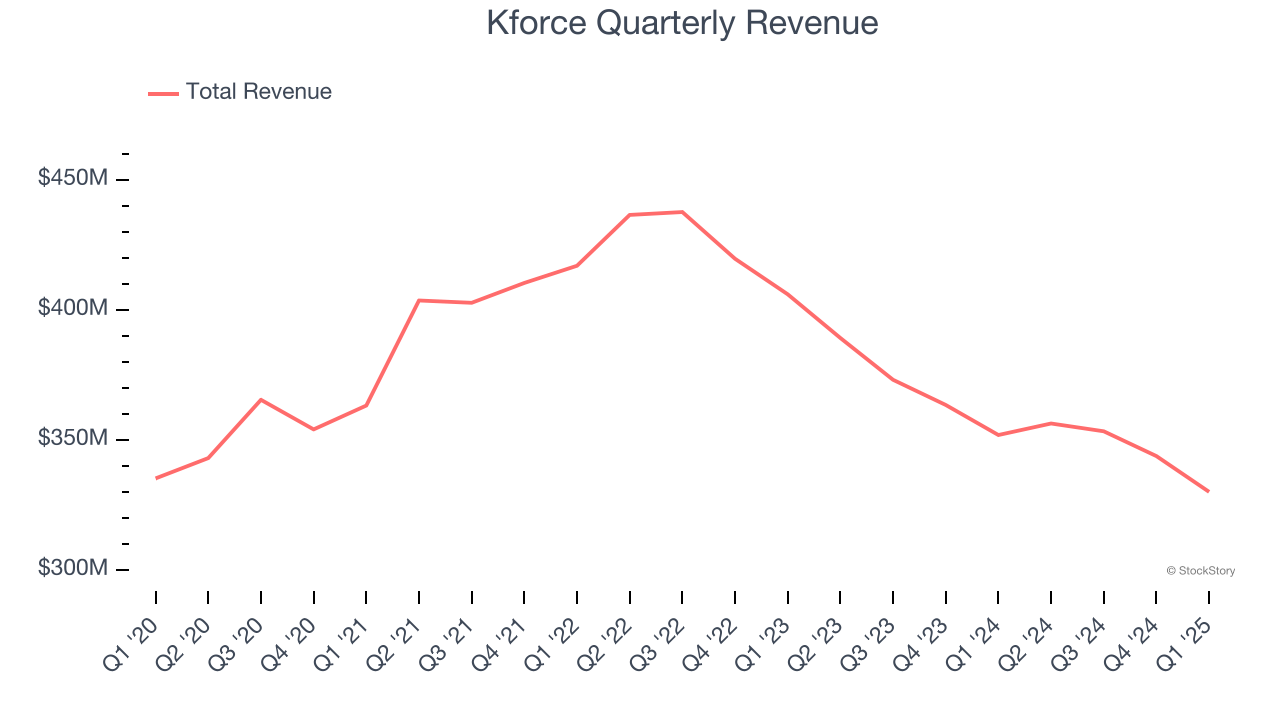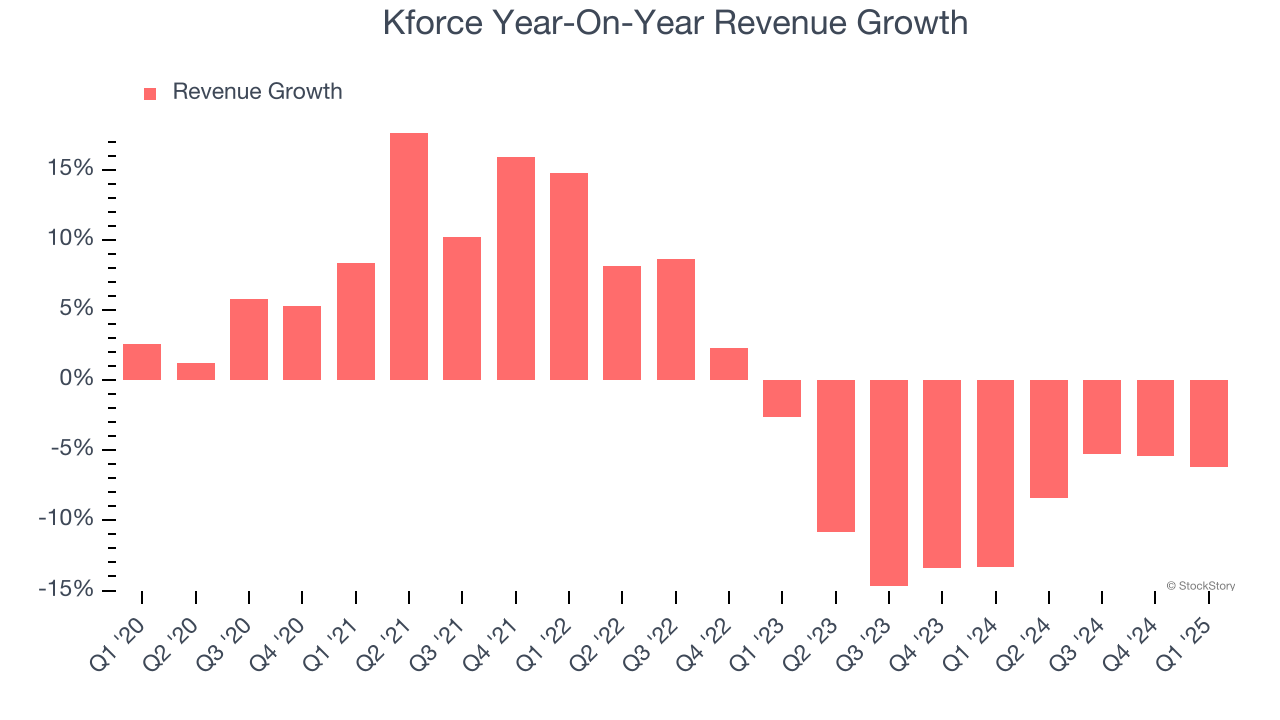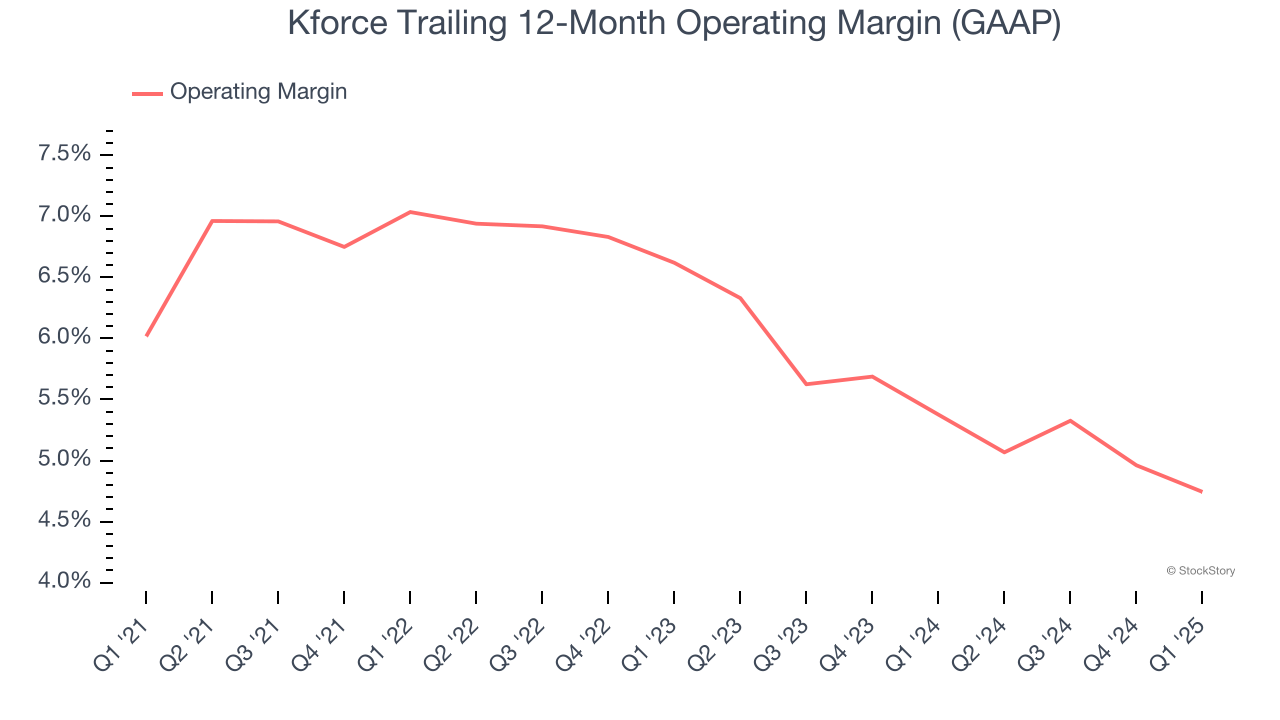
Professional staffing firm Kforce (NYSE:KFRC) missed Wall Street’s revenue expectations in Q1 CY2025, with sales falling 6.2% year on year to $330 million. Next quarter’s revenue guidance of $336 million underwhelmed, coming in 2% below analysts’ estimates. Its GAAP profit of $0.45 per share was 3.3% below analysts’ consensus estimates.
Is now the time to buy Kforce? Find out by accessing our full research report, it’s free.
Kforce (KFRC) Q1 CY2025 Highlights:
- Revenue: $330 million vs analyst estimates of $333.5 million (6.2% year-on-year decline, 1% miss)
- EPS (GAAP): $0.45 vs analyst expectations of $0.47 (3.3% miss)
- Adjusted EBITDA: $16.75 million vs analyst estimates of $16.95 million (5.1% margin, 1.2% miss)
- Revenue Guidance for Q2 CY2025 is $336 million at the midpoint, below analyst estimates of $342.9 million
- EPS (GAAP) guidance for Q2 CY2025 is $0.61 at the midpoint, missing analyst estimates by 6.7%
- Operating Margin: 3.5%, in line with the same quarter last year
- Free Cash Flow was -$3.9 million, down from $11.29 million in the same quarter last year
- Market Capitalization: $799.2 million
Company Overview
With nearly 60 years of matching skilled professionals with the right opportunities, Kforce (NYSE:KFRC) is a professional staffing company that specializes in placing technology and finance experts with businesses on both temporary and permanent bases.
Sales Growth
Examining a company’s long-term performance can provide clues about its quality. Any business can have short-term success, but a top-tier one grows for years.
With $1.38 billion in revenue over the past 12 months, Kforce is a small player in the business services space, which sometimes brings disadvantages compared to larger competitors benefiting from economies of scale and numerous distribution channels.
As you can see below, Kforce struggled to increase demand as its $1.38 billion of sales for the trailing 12 months was close to its revenue five years ago. This shows demand was soft, a rough starting point for our analysis.

We at StockStory place the most emphasis on long-term growth, but within business services, a half-decade historical view may miss recent innovations or disruptive industry trends. Kforce’s recent performance shows its demand remained suppressed as its revenue has declined by 9.8% annually over the last two years. 
This quarter, Kforce missed Wall Street’s estimates and reported a rather uninspiring 6.2% year-on-year revenue decline, generating $330 million of revenue. Company management is currently guiding for a 5.7% year-on-year decline in sales next quarter.
Looking further ahead, sell-side analysts expect revenue to remain flat over the next 12 months. Although this projection indicates its newer products and services will fuel better top-line performance, it is still below the sector average.
Unless you’ve been living under a rock, it should be obvious by now that generative AI is going to have a huge impact on how large corporations do business. While Nvidia and AMD are trading close to all-time highs, we prefer a lesser-known (but still profitable) stock benefiting from the rise of AI. Click here to access our free report one of our favorites growth stories.
Operating Margin
Operating margin is one of the best measures of profitability because it tells us how much money a company takes home after subtracting all core expenses, like marketing and R&D.
Kforce was profitable over the last five years but held back by its large cost base. Its average operating margin of 6% was weak for a business services business.
Analyzing the trend in its profitability, Kforce’s operating margin decreased by 1.3 percentage points over the last five years. Kforce’s performance was poor no matter how you look at it - it shows that costs were rising and it couldn’t pass them onto its customers.

This quarter, Kforce generated an operating profit margin of 3.5%, in line with the same quarter last year. This indicates the company’s overall cost structure has been relatively stable.
Earnings Per Share
Revenue trends explain a company’s historical growth, but the long-term change in earnings per share (EPS) points to the profitability of that growth – for example, a company could inflate its sales through excessive spending on advertising and promotions.
Sadly for Kforce, its EPS declined by 11.7% annually over the last five years while its revenue was flat. This tells us the company struggled because its fixed cost base made it difficult to adjust to choppy demand.

Diving into the nuances of Kforce’s earnings can give us a better understanding of its performance. As we mentioned earlier, Kforce’s operating margin was flat this quarter but declined by 1.3 percentage points over the last five years. This was the most relevant factor (aside from the revenue impact) behind its lower earnings; taxes and interest expenses can also affect EPS but don’t tell us as much about a company’s fundamentals.
In Q1, Kforce reported EPS at $0.45, down from $0.58 in the same quarter last year. This print missed analysts’ estimates. Over the next 12 months, Wall Street expects Kforce’s full-year EPS of $2.55 to grow 4.9%.
Key Takeaways from Kforce’s Q1 Results
We struggled to find many positives in these results as Kforce missed across all key metrics. Its quarterly revenue and EPS guidance also fell short of Wall Street’s estimates. Overall, this was a weaker quarter. The stock remained flat at $42.76 immediately after reporting.
Big picture, is Kforce a buy here and now? We think that the latest quarter is only one piece of the longer-term business quality puzzle. Quality, when combined with valuation, can help determine if the stock is a buy. We cover that in our actionable full research report which you can read here, it’s free.
